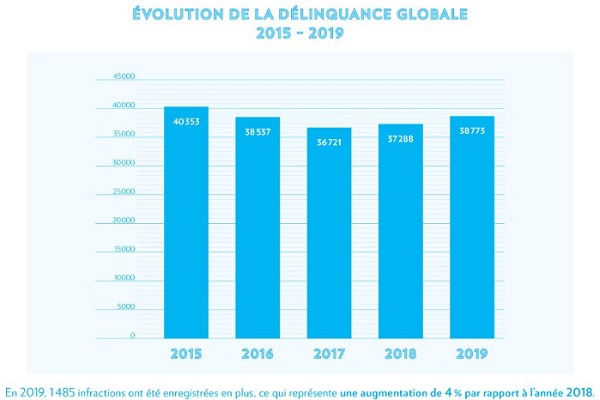 2019 crime statistics evolution to 2019;
Credit: Police Grand Ducale
2019 crime statistics evolution to 2019;
Credit: Police Grand Ducale
The Grand Ducal Police have released nationwide statistics and details of offences against property and people for 2019; details and annual statistics concerning the fight against narcotics and burglaries will be released shortly.
The number of offences against property and people increased slightly by 4% from 2018 to 2019, reaching around 38,800 offences recorded by the Police in 2019 - a figure which remains, despite the growth of the population, below the 40,000+ offences recorded in 2015. Comparing this data to the number of inhabitants to establish the crime rate per 100,000 people shows a general decrease in recent years.
Offences against property commonly represent the largest proportion of total offences. Compared to 2018, the number of offences reported to the Police in this category decreased by 3%. Meanwhile, crimes against persons reported to the Police increased by 8.9%.
Property offences
According to the Police, thefts with violence have been fairly stable since 2016 and remain at a significantly lower level than in 2015 (412 in 2019 compared to 494 in 2015), with 401 in 2018. For several years now, no armed robberies have been recorded against banking institutions or money carriers. For 2019, eight armed robberies on other businesses and establishments (bookstores, food / self-service stores, jewellery stores, etc.) were recorded.
For vehicle-related thefts, the overall figures fell from 2018 to 2019. This category mainly includes theft from inside a vehicle. Other types of theft, including shoplifting and pick-pocketing, for example, fell 3.6% over the same period.
Offences against persons
Among offenses against persons, it is clear that there was an increase of 7.4% in assault and battery from 2018 to 2019.
Domestic violence also saw an increase in cases reported to the Police from 2018 to 2019.
There were 4 murders in 2019, compared to 3 in 2018, 2 in 2017 and 5 in both 2016 and 2015.
The police rate of solving crimes is at its highest level for five years, with an increase of more than 8% since 2015, with 53.2% for 2019 and 50.7% for 2018; 2017 was a low-point with just 44.7% of cases solved that year. A case is considered solved when the alleged perpetrator could be identified. Nevertheless, the presumption of innocence remains until a possible conviction.








